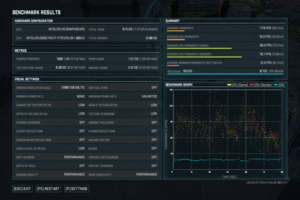Intel HD Graphics 615 vs NVIDIA GeForce RTX 3070 Ti Laptop GPU vs Intel HD Graphics 630
Intel HD Graphics 615
► remove from comparison
Die Intel HD Graphics 615 (GT2) ist eine Prozessorgrafikkarte der im Sommer 2016 vorgestellten Kaby-Lake-Generation. Als Nachfolger der Intel HD Graphics 515 (Skylake) ist die HD 615 dabei in der besonders sparsamen Y-Serie mit 4,5 Watt TDP zu finden. Die sogenannte GT2-Ausbaustufe der Kaby-Lake-GPU verfügt über 24 Ausführungseinheiten (EUs) und taktet je nach Modell mit bis zu 1.050 MHz.
Mangels eigenem Grafikspeicher oder eDRAM-Cache greift die HD Graphics 615 über das Interface des Prozessors auf den System-RAM zu (2x 64 Bit DDR3L/LPDDR3).
Performance
Die exakte Leistung der HD Graphics 615 hängt stark vom jeweiligen CPU-Modell sowie dem konkreten Endgerät ab, da sich Maximaltaktrate sowie TDP-Konfiguration/Kühlung erheblich unterscheiden können. Zum anderen bestimmt auch der verwendete Speicher (DDR3L/LPDDR3) die Performance. Insgesamt dürfte die HD 615 etwa 20 bis 30 Prozent schneller als ihr Vorgänger HD Graphics 515 rechnen und im Optimalfall in etwa das Niveau der HD Graphics 520 erreichen. Einige Spiele des Jahres 2016 können so in niedrig(st)en Einstellungen flüssig dargestellt werden.
Anders als Skylake kann Kaby Lake nun auch H.265/HEVC im Main10-Profil mit 10 Bit Farbtiefe sowie Googles VP9-Codec in Hardware decodieren. Die ersten ausgelieferten Kaby-Lake CPUs unterstützen allerdings noch kein HDCP 2.2, was beispielsweise für die Ausgabe von Netflix-Videos in 4K benötigt wird. Dies wurde erst ab 2017 mit den neuen CPUs und ab April mit den alten CPUs (neue Kennung) ermöglicht. HDMI 2.0 unterstützt die HD Graphics 615 jedoch weiterhin nur per Wandler (LSPCon) über den DisplayPort.
Leistungsaufnahme
Die HD Graphics 615 ist in ULV-Prozessoren der 4,5-Watt-Klasse zu finden (TDP kann vom Gerätehersteller angepasst werden) und damit für passiv gekühlte Tablets und Ultrabooks geeignet.
NVIDIA GeForce RTX 3070 Ti Laptop GPU
► remove from comparison
Die Nvidia GeForce RTX 3070 Ti Laptop GPU oder 3070 Ti Mobile (für Laptops, GN20-E6, Max-P / Max-Q) ist der Refresh der RTX 3070 zur CES Anfang 2022. Sie basiert auf den selben GA104 Chip wie the RTX 3070 Laptop GPU und bietet mit 5888 15% mehr Shader als die Vorgängergeneration. Der Boost Takt wurde aber wahrscheinlich etwas reduziert. Die GPU bietet einen 256 Bit Speicherbus und 8 GB GDDR6 Grafikspeicher. Es gibt verschiedene Varianten mit unterschiedlichen Taktraten und TGP Einstellungen von 80 - 125 Watt. Je nach Variante, unterscheidet sich auch der maximale Boost-Takt von 1035 MHz (80W) bis 1485 MHz (125W). Es gibt aber keine Max-Q Variante mehr (die 80 - 90 Watt Versionen heissen auch nur "Laptop GPU"), aber jede TGP-Version kann die Max-Q Technologien nutzen (Dynamic Boost, Whispermode).
Die Leistung sollte zwischen der alten RTX 3070 Mobile und RTX 3080 Mobile liegen. Damit eignet sich die RTX 3070Ti Mobile am besten für QHD und maximale Settings bei anspruchsvollen Spielen (wie Cyberpunk 2077 oder Halo Infinite) bzw. 4K bei weniger anspruchsvollen Spielen (wie Farming Simulator 22).
Der GA104 Chip bietet 6144 FP32 ALUs wovon die Hälfte auch INT32 Befehle ausführen können (also 3072 INT32 ALUs). Bei Turing konnten noch alle Shader FP32 oder INT32 ausführen. Die Raytracing und Tensor Kerne auf dem Chip wurden laut Nvidia ebenfalls verbessert. Die RTX 3070 Ti nutzt 5888 der 6144 Kerne. Weiters integriert der Ampere Chip einen Hardware Video-Encoder (NVENC 5. Generation für H.264 und H.265) und Decoder (7. Generation für zahlreiche Formate inklusive AV1).
Der GA104 Chip wird bei Samsung im 8nm (8N) Verfahren welches mit dem 7nm Verfahren von TSMC nicht ganz mithalten kann (z.B. von AMD genutzt, aber auch für den professionellen GA100 Ampere Chip).
Intel HD Graphics 630
► remove from comparisonDie Intel HD Graphics 630 (GT2) ist eine integrierte Grafikeinheit, die in verschiedenen Desktop- und Notebook-Prozessoren der 2016-2017 vorgestellten Kaby-Lake-Generation zu finden ist. Die mittlere, auch "GT2" genannte Ausbaustufe verfügt über 24 EUs (Execution Units bzw. Ausführungseinheiten). Technisch unterscheidet sie sich von der HD Graphics 530 der Skylake Generation nicht, die Taktraten könnten jedoch minimal höher sein und auch der Turbo könnte dank des verbesserten 14nm+ Prozess schneller anspringen.
Performance
Die exakte Leistung der HD Graphics 630 hängt vom jeweiligen CPU-Modell ab, da sich TDP, Maximaltaktrate und Größe des L3-Caches teils stark unterscheiden können. Zum anderen bestimmt auch der verwendete Speicher (DDR3/DDR4) die Performance. Im Durchschnitt sollte die Leistung jedoch nur minimal oberhalb der Intel HD Graphics 530 liegen, wodurch sich anspruchsvolle Spiele aus 2016 wie Watch Dogs 2, Dishonored 2 oder Mafia 3 nicht spielbar sind. Weniger anspruchsvolle Spiele wie Overwatch oder Farming Simulator 17 sind jedoch in niedrigen Details flüssig spielbar. Siehe auch die Seite der Intel HD Graphics 530 für weitere Spielebenchmarks.
Features
Neu bei der Kaby-Lake Generation ist die verbesserte Videoengine, welche nun auch H.265/HEVC im Main10-profil mit 10 Bit Farbtiefe sowie Googles VP9-Codec in Hardware dekodieren kann. Die Chips mit HD Graphics 530 sollten auch bereits HDCP 2.2 unterstützen und somit z.B. Netflix-Videos unter Windows 10 in 4K ausgeben können (im Gegensatz zu den ersten Kaby-Lake Dual-Core Chips mit Intel HD Graphics 620). HDMI 2.0 unterstützt die HD Graphics 630 jedoch weiterhin nur per Wandler (LSPCon) über den DisplayPort.
Leistungsaufnahme
Die HD Graphics 630 ist in Desktop- und Notebook-Prozessoren verschiedener TDP-Klassen zu finden. Die Quad-Core CPUs sind jedoch meistens in größeren und schwereren Notebooks verbaut. Der verbesserte 14nm+ Prozess verspricht jedoch eine etwas geringere Leistungsaufnahme im Vergleich zur Intel HD Graphics 530.
| Intel HD Graphics 615 | NVIDIA GeForce RTX 3070 Ti Laptop GPU | Intel HD Graphics 630 | |||||||||||||||||||||||||||||||||||||||||||||||||||||||||||||||||||||||||||||||||||||||||||||||||||||||||||||||||||||||||||||||||||||||||||||||||
| Gen. 9.5 Serie |
|
|
| ||||||||||||||||||||||||||||||||||||||||||||||||||||||||||||||||||||||||||||||||||||||||||||||||||||||||||||||||||||||||||||||||||||||||||||||||
| Codename | Kaby-Lake GT2 | GN20-E6 | Kaby-Lake-H-GT2 | ||||||||||||||||||||||||||||||||||||||||||||||||||||||||||||||||||||||||||||||||||||||||||||||||||||||||||||||||||||||||||||||||||||||||||||||||
| Architektur | Gen. 9 Kaby Lake | Ampere | Gen. 9.5 Kaby Lake | ||||||||||||||||||||||||||||||||||||||||||||||||||||||||||||||||||||||||||||||||||||||||||||||||||||||||||||||||||||||||||||||||||||||||||||||||
| Pipelines | 24 - unified | 5888 - unified | 24 - unified | ||||||||||||||||||||||||||||||||||||||||||||||||||||||||||||||||||||||||||||||||||||||||||||||||||||||||||||||||||||||||||||||||||||||||||||||||
| Kerntakt | 300 - 1050 (Boost) MHz | 915 - 1480 (Boost) MHz | 300 - 1150 (Boost) MHz | ||||||||||||||||||||||||||||||||||||||||||||||||||||||||||||||||||||||||||||||||||||||||||||||||||||||||||||||||||||||||||||||||||||||||||||||||
| Speicherbandbreite | 64/128 Bit | 256 Bit | 64/128 Bit | ||||||||||||||||||||||||||||||||||||||||||||||||||||||||||||||||||||||||||||||||||||||||||||||||||||||||||||||||||||||||||||||||||||||||||||||||
| Speichertyp | DDR3L/LPDDR3 | GDDR6 | |||||||||||||||||||||||||||||||||||||||||||||||||||||||||||||||||||||||||||||||||||||||||||||||||||||||||||||||||||||||||||||||||||||||||||||||||
| Shared Memory | ja | nein | ja | ||||||||||||||||||||||||||||||||||||||||||||||||||||||||||||||||||||||||||||||||||||||||||||||||||||||||||||||||||||||||||||||||||||||||||||||||
| API | DirectX 12_1, OpenGL 4.4 | DirectX 12_2, Shader 6.7, OpenGL 4.6 | DirectX 12_1, OpenGL 4.4 | ||||||||||||||||||||||||||||||||||||||||||||||||||||||||||||||||||||||||||||||||||||||||||||||||||||||||||||||||||||||||||||||||||||||||||||||||
| Herstellungsprozess | 14 nm | 8 nm | 14 nm | ||||||||||||||||||||||||||||||||||||||||||||||||||||||||||||||||||||||||||||||||||||||||||||||||||||||||||||||||||||||||||||||||||||||||||||||||
| Features | QuickSync | NVIDIA DLSS, NVIDIA Reflex, Resizable BAR, NVIDIA Broadcast, NVIDIA Ansel, NVIDIA ShadowPlay®, NVIDIA G-SYNC®, Advanced Optimus, Nvidia Max-Q, Dynamic Boost, VR-ready, Nvidia Omniverse | QuickSync | ||||||||||||||||||||||||||||||||||||||||||||||||||||||||||||||||||||||||||||||||||||||||||||||||||||||||||||||||||||||||||||||||||||||||||||||||
| Erscheinungsdatum | 30.08.2016 | 04.01.2022 | 05.08.2015 | ||||||||||||||||||||||||||||||||||||||||||||||||||||||||||||||||||||||||||||||||||||||||||||||||||||||||||||||||||||||||||||||||||||||||||||||||
| TMUs | 184 | ||||||||||||||||||||||||||||||||||||||||||||||||||||||||||||||||||||||||||||||||||||||||||||||||||||||||||||||||||||||||||||||||||||||||||||||||||
| ROPs | 96 | ||||||||||||||||||||||||||||||||||||||||||||||||||||||||||||||||||||||||||||||||||||||||||||||||||||||||||||||||||||||||||||||||||||||||||||||||||
| Raytracing Cores | 46 | ||||||||||||||||||||||||||||||||||||||||||||||||||||||||||||||||||||||||||||||||||||||||||||||||||||||||||||||||||||||||||||||||||||||||||||||||||
| Tensor / AI Cores | 184 | ||||||||||||||||||||||||||||||||||||||||||||||||||||||||||||||||||||||||||||||||||||||||||||||||||||||||||||||||||||||||||||||||||||||||||||||||||
| Speichertakt | 14000 effective = 1750 MHz | ||||||||||||||||||||||||||||||||||||||||||||||||||||||||||||||||||||||||||||||||||||||||||||||||||||||||||||||||||||||||||||||||||||||||||||||||||
| Max. Speichergröße | 8 GB | ||||||||||||||||||||||||||||||||||||||||||||||||||||||||||||||||||||||||||||||||||||||||||||||||||||||||||||||||||||||||||||||||||||||||||||||||||
| Memory Bandwidth | 448 GB/s | ||||||||||||||||||||||||||||||||||||||||||||||||||||||||||||||||||||||||||||||||||||||||||||||||||||||||||||||||||||||||||||||||||||||||||||||||||
| Stromverbrauch | 125 Watt (80 - 125 Watt TGP) | ||||||||||||||||||||||||||||||||||||||||||||||||||||||||||||||||||||||||||||||||||||||||||||||||||||||||||||||||||||||||||||||||||||||||||||||||||
| Transistors | 17.4 Billion | ||||||||||||||||||||||||||||||||||||||||||||||||||||||||||||||||||||||||||||||||||||||||||||||||||||||||||||||||||||||||||||||||||||||||||||||||||
| Die Size | 392 mm² | ||||||||||||||||||||||||||||||||||||||||||||||||||||||||||||||||||||||||||||||||||||||||||||||||||||||||||||||||||||||||||||||||||||||||||||||||||
| PCIe | 4.0 | ||||||||||||||||||||||||||||||||||||||||||||||||||||||||||||||||||||||||||||||||||||||||||||||||||||||||||||||||||||||||||||||||||||||||||||||||||
| Displays | HDMI 2.1, DisplayPort 1.4a | ||||||||||||||||||||||||||||||||||||||||||||||||||||||||||||||||||||||||||||||||||||||||||||||||||||||||||||||||||||||||||||||||||||||||||||||||||
| Notebookgröße | groß (17" z.B.) |
|
| |||||||||||||||||||||||||||||||||||||||||||||||||
Benchmarks
3DM Vant. Perf. total + Intel HD Graphics 615
specvp11 snx-01 + Intel HD Graphics 630
Cinebench R15 OpenGL 64 Bit + Intel HD Graphics 615
GFXBench T-Rex HD Offscreen C24Z16 + Intel HD Graphics 615
Average Benchmarks Intel HD Graphics 615 → 100% n=21
Average Benchmarks NVIDIA GeForce RTX 3070 Ti Laptop GPU → 1812% n=21
Average Benchmarks Intel HD Graphics 630 → 155% n=21
* Smaller numbers mean a higher performance
1 This benchmark is not used for the average calculation
Spiele-Benchmarks
Die folgenden Benchmarks basieren auf unseren Spieletests mit Testnotebooks. Die Performance dieser Grafikkarte bei den gelisteten Spielen ist abhängig von der verwendeten CPU, Speicherausstattung, Treiber und auch Betriebssystem. Dadurch müssen die untenstehenden Werte nicht repräsentativ sein. Detaillierte Informationen über das verwendete System sehen Sie nach einem Klick auf den fps-Wert.

Lords of the Fallen
2023
EA Sports FC 24
2023
Baldur's Gate 3
2023
Lies of P
2023
The Crew Motorfest
2023
Starfield
2023
Armored Core 6
2023
Immortals of Aveum
2023
Atlas Fallen
2023
F1 23
2023
Diablo 4
2023
Dead Island 2
2023
Company of Heroes 3
2023
Sons of the Forest
2023
Atomic Heart
2023
Returnal
2023
Hogwarts Legacy
2023
Dead Space Remake
2023
The Witcher 3 v4.00
2023
High On Life
2023
The Quarry
2022
F1 22
2022
Vampire Bloodhunt
2022
Ghostwire Tokyo
2022
Cyberpunk 2077 1.6
2022
Elex 2
2022
GRID Legends
2022
Elden Ring
2022
Dying Light 2
2022
God of War
2022
Halo Infinite
2021
Farming Simulator 22
2021
Battlefield 2042
2021
Forza Horizon 5
2021
Riders Republic
2021
Back 4 Blood
2021
Far Cry 6
2021
Alan Wake Remastered
2021
New World
2021
Deathloop
2021
F1 2021
2021
Days Gone
2021
Outriders
2021
Hitman 3
2021
Cyberpunk 2077 1.0
2020
Yakuza Like a Dragon
2020
Dirt 5
2020
Watch Dogs Legion
2020
Star Wars Squadrons
2020
Serious Sam 4
2020
Crysis Remastered
2020
Death Stranding
2020
Valorant
2020
Gears Tactics
2020
Doom Eternal
2020
Hunt Showdown
2020
Hearthstone
2020
Fall Guys
2020
Need for Speed Heat
2019
FIFA 20
2019
Borderlands 3
2019
Control
2019
F1 2019
2019
League of Legends
2019
The Division 2
2019
Dirt Rally 2.0
2019
Far Cry New Dawn
2019
Metro Exodus
2019
Apex Legends
2019
Just Cause 4
2018
Battlefield V
2018
Farming Simulator 19
2018
Fallout 76
2018
FIFA 19
2018
Monster Hunter World
2018
The Crew 2
2018
Far Cry 5
2018
X-Plane 11.11
2018
Fortnite
2018
Call of Duty WWII
2017
Destiny 2
2017
ELEX
2017
The Evil Within 2
2017
FIFA 18
2017
Ark Survival Evolved
2017
F1 2017
2017
Team Fortress 2
2017
Dirt 4
2017
Rocket League
2017
Prey
2017
For Honor
2017
Resident Evil 7
2017
Watch Dogs 2
2016
Dishonored 2
2016
Titanfall 2
2016
Farming Simulator 17
2016
Battlefield 1
2016
Civilization VI
2016
FIFA 17
2016
Overwatch
2016
Doom
2016
Hitman 2016
2016
The Division
2016
Far Cry Primal
2016
Rainbow Six Siege
2015
Just Cause 3
2015
Anno 2205
2015
World of Warships
2015
Metal Gear Solid V
2015
Dota 2 Reborn
2015
The Witcher 3
2015
Dirt Rally
2015
GTA V
2015
Battlefield Hardline
2015
F1 2014
2014
Alien: Isolation
2014
Sims 4
2014
GRID: Autosport
2014
Battlefield 4
2013
Total War: Rome II
2013
Metro: Last Light
2013
BioShock Infinite
2013
Tomb Raider
2013
Hitman: Absolution
2012
Counter-Strike: GO
2012
Diablo III
2012
Mafia 2
2010Average Gaming Intel HD Graphics 615 → 100%
Average Gaming 30-70 fps → 100%
Average Gaming NVIDIA GeForce RTX 3070 Ti Laptop GPU → 1509%
Average Gaming Intel HD Graphics 630 → 174%
Average Gaming 30-70 fps → 184%
| NVIDIA GeForce RTX 3070 Ti Laptop GPU | low | med. | high | ultra | QHD | 4K |
|---|---|---|---|---|---|---|
| Lords of the Fallen | 76.6 | 56.4 | 39.4 | 27 | 10.9 | |
| Assassin's Creed Mirage | 106 | 102 | 80 | 63 | 40 | |
| EA Sports FC 24 | 154 | 134.2 | 129.7 | 129.2 | 81.8 | |
| Cyberpunk 2077 2.1 Phantom Liberty | 99 | 90.7 | 81.9 | 54 | 26.3 | |
| Baldur's Gate 3 | 110.9 | 94.9 | 93.4 | 66.3 | 34 | |
| Lies of P | 151.3 | 134.1 | 121.1 | 84.7 | 44.9 | |
| The Crew Motorfest | 60 | 60 | 60 | 55 | 35 | |
| Starfield | 61.7 | 50 | 44.8 | 36.2 | 23.5 | |
| Armored Core 6 | 96.3 | 89.5 | 84.6 | 74.5 | 47.6 | |
| Immortals of Aveum | 52.5 | 42.7 | 29.9 | 16.1 | ||
| Atlas Fallen | 124.2 | 118.6 | 101.7 | 77.8 | 47.3 | |
| Ratchet & Clank Rift Apart | 73.9 | 59.5 | 55 | 45.8 | 30.6 | |
| F1 23 | 229 | 178 | 63 | 41 | 19 | |
| Diablo 4 | 280 | 248 | 223 | 189.2 | 129.6 | 67.4 |
| Star Wars Jedi Survivor | 79.5 | 74.3 | 71.8 | 46 | 22.8 | |
| Dead Island 2 | 198.6 | 173.3 | 134.1 | 95.1 | 48.5 | |
| Resident Evil 4 Remake | 121.5 | 110.7 | 81.7 | 61.4 | 35.4 | |
| Company of Heroes 3 | 186 | 148 | 146 | 109 | 67 | |
| Sons of the Forest | 85 | 82.8 | 81.7 | 65.5 | 44.2 | |
| Atomic Heart | 157.9 | 94.5 | 76.3 | 60.2 | 37 | |
| Returnal | 113 | 103 | 89 | 66 | 39 | |
| Hogwarts Legacy | 88.5 | 79 | 69.7 | 59.3 | 42.6 | |
| Dead Space Remake | 82.1 | 74.6 | 68.1 | 66.8 | 47.2 | |
| The Witcher 3 v4.00 | 174.4 | 149.6 | 81.3 | 71.4 | 47.4 | |
| High On Life | 175.7 | 139.4 | 117.5 | 97.1 | 60.8 | |
| The Callisto Protocol | 117 | 99.3 | 71 | 70.7 | 52.8 | |
| Need for Speed Unbound | 112.8 | 106.9 | 93 | 84.6 | 66.7 | |
| Spider-Man Miles Morales | 108 | 103 | 94 | 92 | 72 | |
| Call of Duty Modern Warfare 2 2022 | 127 | 112 | 88 | 85 | 62 | |
| Uncharted Legacy of Thieves Collection | 80 | 78 | 74 | 71 | 56 | |
| A Plague Tale Requiem | 98 | 83 | 72 | 62 | 50 | |
| FIFA 23 | 104.3 | |||||
| The Quarry | 153 | 120 | 100 | 81 | 56.1 | |
| F1 22 | 210 | 207 | 176 | 67 | 43 | |
| Vampire Bloodhunt | 197.6 | 195 | 184 | 179 | 128.4 | |
| Ghostwire Tokyo | 154 | 144 | 138 | 133 | 89 | |
| Tiny Tina's Wonderlands | 183.3 | 162 | 116 | 91 | 62 | |
| Cyberpunk 2077 1.6 | 130 | 113 | 93 | 79 | 50 | 26 |
| Elex 2 | 110 | 104 | 90 | 81 | ||
| GRID Legends | 198 | 169 | 149 | 113 | 99 | |
| Elden Ring | 59.8 | 60 | 53 | 59.7 | ||
| Dying Light 2 | 106 | 84 | 73 | 52 | 28.3 | |
| Rainbow Six Extraction | 210 | 182 | 177 | 140 | 91 | 46 |
| God of War | 121 | 100 | 85 | 60 | 45 | 31.5 |
| Halo Infinite | 125 | 107 | 101 | 65.5 | 34.6 | |
| Farming Simulator 22 | 183 | 160 | 141 | 115 | 69.7 | |
| Battlefield 2042 | 136.4 | 113 | 99 | 88 | 63.2 | 39.5 |
| Forza Horizon 5 | 195 | 133 | 125 | 78 | 65 | 47 |
| Riders Republic | 189 | 133 | 110 | 101 | 70 | 39 |
| Guardians of the Galaxy | 120 | 118 | 118 | 114 | 87 | 49 |
| Back 4 Blood | 220 | 192 | 182 | 122 | 63.9 | |
| Far Cry 6 | 149 | 113 | 100 | 92 | 72 | 38 |
| Alan Wake Remastered | 169.3 | 145 | 138 | 104 | 56.7 | |
| New World | 104 | 94 | 85 | 64 | 32.2 | |
| Deathloop | 123 | 105 | 85 | 59 | 30.8 | |
| F1 2021 | 343 | 241 | 196 | 110 | 83 | 52 |
| Days Gone | 141 | 125 | 94 | 69 | 36.9 | |
| Mass Effect Legendary Edition | 135 | 124 | 80.5 | |||
| Resident Evil Village | 185 | 169 | 148 | 101 | 52.9 | |
| Outriders | 145 | 130 | 110 | 75 | 37.4 | |
| Hitman 3 | 229 | 174 | 158 | 151 | 95.8 | 54.3 |
| Cyberpunk 2077 1.0 | 82.1 | 66.9 | 56.1 | 35.9 | 17.5 | |
| Yakuza Like a Dragon | 117 | 113 | 100 | 68.5 | 37 | |
| Assassin´s Creed Valhalla | 159 | 107 | 89 | 77 | 60 | 36 |
| Dirt 5 | 219 | 130 | 105 | 84 | 64 | 41.6 |
| Watch Dogs Legion | 121 | 107 | 97 | 68 | 50 | 29 |
| Star Wars Squadrons | 292 | 269 | 237 | 167 | 92.9 | |
| Mafia Definitive Edition | 161.8 | 111 | 103 | 66.1 | 35.7 | |
| Serious Sam 4 | 110 | 99.2 | 82.4 | 64.2 | 40.5 | |
| Crysis Remastered | 178 | 71.8 | 64.3 | 48.5 | 27.6 | |
| Flight Simulator 2020 | 124.8 | 97.8 | 70.2 | 52.2 | 41.3 | |
| Death Stranding | 156.9 | 141 | 135 | 133 | 94.4 | 55.2 |
| Gears Tactics | 204 | 135 | 102 | 75.2 | 40.1 | |
| Doom Eternal | 365 | 231 | 202 | 193 | 145 | 78.2 |
| Hunt Showdown | 139 | 121 | 79 | 36.5 | ||
| Borderlands 3 | 104.2 | 92.4 | 80.9 | 58.7 | ||
| Metro Exodus | 145 | 117 | 93 | 74 | 52.7 | |
| Shadow of the Tomb Raider | 128 | 124 | 83 | |||
| Strange Brigade | 396 | 245 | 203 | 180 | 137 | 81 |
| Far Cry 5 | 164 | 136 | 130 | 120 | 97 | 59 |
| X-Plane 11.11 | 135 | 118 | 96 | 95 | ||
| Final Fantasy XV Benchmark | 184 | 134 | 99 | 76 | 44 | |
| Dota 2 Reborn | 166 | 151 | 143 | 136 | 118 | |
| The Witcher 3 | 388 | 294 | 189 | 102 | 76 | |
| GTA V | 179 | 176 | 166 | 107 | 93 | 95 |
| < 30 fps < 60 fps < 120 fps ≥ 120 fps | 9 36 | 1 37 43 | 4 48 31 | 8 50 20 | 2 25 46 8 | 11 38 13 |
Eine Liste mit weiteren Spielen und allen Grafikkarten finden Sie auf unserer Seite: Welches Spiel ist mit welcher Grafikkarte spielbar?









































































